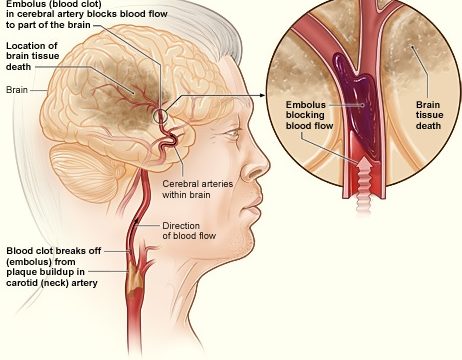
Imagine the following trail of events: You start to observe or more F.A.S.T. stroke symptoms and signs in a person; you call an ambulance; emergency responders arrive at the scene; they determine of a stroke; they rush the person to a stroke unit; the person is treated with a blot clot-dissolving medication. If all these events occur within the first hour from the time of detection, that is the golden hour.
What is the “golden hour”?
The “golden hour” of a stroke refers to the first hour after the onset of stroke symptoms. This term highlights the importance of recognizing the signs of a stroke and seeking immediate medical attention in order to minimize the damage to the brain and maximize the chances of recovery.
What happens in the golden hour?
During the golden hour, the blood flow to the brain is disrupted, and the affected brain cells are at risk of dying. The longer the blood flow remains disrupted, the more brain cells are lost, and the greater the damage to the brain.
Therefore, it is important to seek medical attention as soon as possible after the onset of stroke symptoms.
“Time is brain”
Every passing second matters. And this is why we call, it “Time is Brain”. Time is the critical factor; 32,000 neurons die every passing second as Jeffrey L. Savers wrote in 2005. It also includes not only 32,000 neurons, 230 million synapses, and 200 meters of axons per second. In terms of minutes, each passing minute costs 1.9 million neurons, 13.8 billion synapses, and 12 kilometres of axonal fibres1.
Stroke kills 32,000 neurons each passing second.
Saver J.L. (20051)
As far back as 1993, Dr Camilo R. Gomez2 coined this exhortation – “Time is Brain” – in an editorial to the Journal of Stroke and Cerebrovascular Diseases.
Wait!
There is a caveat.
Why?
In 2018, Dr Gomez3 updated his “Time is Brain” slogan!
It is because the neurons and other brain cells’ dying speed is not linear. It depends on the affected person’s collateral system.
What does that mean?
We all have a backup blood supply mechanism, just in case. When the main supply route is blocked, our alternate support system gets activated. We still do not know how wide this mechanism operates. What we do know is that its spread varies from person to person.
In other words, the “Tims is Brain” slogan is still valid. We should act F.A.S.T. even the golden hour elapses.
How long a neuron can survive after a stroke?
I had this question when I began writing this post.
I found an answer.
As far back as 1981, Jones and a team of researchers have attempted to answer this question using monkeys. They found no irreversible damage when the blood supply restores in 30 minutes (Jones et al. 19814).
Then, there was another significant finding!
When blood supply was not blocked – only reduced to 12, 18ml/100g/min (this is called mild-moderate ischemia) – even after 2 – 3 hours, the affected cells survived! That means only when the blood supply was reduced to less than 10-12ml/100g/min the damage was irreversible (Jones et al. 1981).
Within the first 3 – 8 days after a stroke, the affected area swells more than the volume of this area. Then, re-organisation and retraction remove the dead tissues resulting in an amount smaller than the pre-affected brain area within the next two weeks to 3 months time (Saver J.L. 2005).
However, passing this golden hour does not mean that we should lose hope of salvaging the affected brain tissues. The Canadian best practice guidelines advocate the onset-to-needle time as “four and a half hours” (page 3) from the onset of symptoms.
References
- Saver J.L. (2005). Time is brain – quantified. Stroke. 2005;37:263–266.
- Gomez C.R. (1993). Time is Brain. J Stroke Cerebrovas Disc. 3(1):1-2.
- Gomez. C.R. (2018). Time Is Brain: The Stroke Theory of Relativity. Journal of Stroke and Cerebrovascular Diseases, 27 (8):2214-2227.
- Jones TH, Morawetz RB, Crowell RM, Marcoux FW, FitzGibbon SJ, DeGirolami U, et al.. Thresholds of focal cerebral ischemia in awake monkeys.J Neurosurg. 1981;54:773–782.
- Advani R, Naess H. & Kurz M.W. (2017). The golden hour of
acute ischemic stroke. Scand J Trauma Resusc Emerg Med. 2017 May 22;25(1):54.doi




